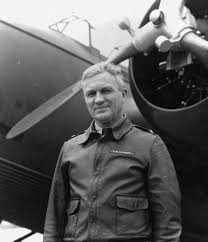Monuments
Fallen but Not Forgotten & General Andrews Memorial - B-24 “Hot Stuff” (41-23728) Crash Site
819th Engineer Aviation Battalion Plaque

Frank M. Andrews was born on February 3, 1884 and was from Nashville, Tennessee. General George C. Marshall said late in life that there was only one general he had been able to "prepare all around" for the supreme command of the invasion of Europe -- and his name was not Ike.
Frank Andrews had been preparing himself for that moment through more than three decades of Army service. But perhaps his greatest contribution to Allied victory happened during his term as commander of the Army's General Headquarters Air Force from 1935 to 1939. In that role, he advocated tirelessly, against the implacable opposition of the top brass, for the acquisition of heavy bombers to defend the country. He managed to keep the B-17 alive as an experimental aircraft so that it could be rolled into mass production once the country recognized that war was coming.
Andrews' advocacy for the B-17 earned him a demotion and exile in 1939, as his superiors sent him to occupy the same dilapidated office on a San Antonio base that his mentor Billy Mitchell had occupied at the time of his disgrace. But when General Marshall became chief of staff later in 1939, his first appointment was to make Andrews his G-3, head of operations and training. The outgoing chief of staff and War Department officials strenuously opposed the appointment, but Marshall threatened to reject his own appointment if thwarted.
Marshall later recalled that recalled that the appointment made Andrews "the first supervisor of the mobilization of the army, which involved about 176 new units." That job had put him "in close touch with the ground forces," Marshall said, and Andrews "did a splendid job" in the role.
When the war came to U.S. territory on December 7, 1941, Lieutenant General Andrews was in command of all U.S. military forces in and around the Panama Canal Zone, which was viewed as a likely target of attack.
In 1942 Andrews went to North Africa, where as commander of all United States' forces in the Middle East, he helped to defeat Rommel's Afrika Korps.
In February 1943 Andrews became the commander of all United States forces in the European Theater of Operations. In his memoirs, Gen Henry H. "Hap" Arnold, commander of the Army Air Forces in WWII, expressed the belief that Andrews would have been given the command of the Allied invasion of Europe -- the position that eventually went to Gen. Dwight D. Eisenhower. Unfortunately, on May 3, 1943, the B-24 carrying Andrews on an inspection tour crashed while attempting to land at the Royal Air Force Base at Kaldadarnes, Iceland. Andrews and 13 others died in the crash, and only the tail gunner survived.
Joint Base Andrews (formerly Andrews Air Force Base), the airport of the president of the United States, is named in honor of Lt. Gen. Frank M. Andrews.
Lt. General Andrews was in the spring of 1943 US commander in the European Theatre of Operations; it was rumoured that he was tipped for an even higher position. The 93rd BG Liberator 'Hot Stuff' - the very first USAAF bomber to complete 25 missions in Europe - was at the time scheduled to return to the USA to promote the sale of War Bonds.
General Andrews chose to fly to Iceland on 'Hot Stuff.' Many believe he had been summoned back to Washington by his boss, General Marshall, although the available evidence suggests he was just planning a quick visit with US forces in Iceland. Accordingly five members of 'Hot Stuff's' crew were offloaded and their places given to General Andrews and his staff. Needing to land in Iceland to refuel they encountered low cloud and snow showers and, following several aborted attempts, crashed into the side of a mountain. Of the fifteen men on board only one - the tail gunner - survived. A memorial to the 14 men who died there was unveiled near the site in May 2018, the 75th anniversary of the accident.
